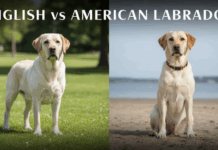Last Updated on March 22, 2021 by Dogs Vets
The Golden Retriever Lab Mix breed, also known as the Goldador, is a cross between two of the most popular and beloved dog breeds in the world. These mixed breeds tend to inherit the good temperament of their parents. They are friendly, energetic and very trainable.
The Labrador Golden Retriever Mix is a large and athletically built dog with a short, thick, waterproof coat. Their size ranges from about 59 to 84 pounds (on average), with females on the lower end of the spectrum.

This mixed breed is generally healthy with some potential health problems. The average life expectancy is about 10 to 12 years, based on the average life span of the parent breeds.
See also: Top 100 best golden doodle names for male and female dogs 2021
The Goldador comes from two large and bouncy breeds and makes a good pet for active families who have plenty of time to play with their four-legged friend.
In this post we will talk about the Goldador’s lineage, expected general appearance and behavior, and possible health issues.
Golden Retriever Lab Mix: Breeding at a glance

- Popularity: a designer breed that mixes two of the most popular dogs in America
- Purpose: Service dogs, therapy dogs, show dogs, hunting dogs, family pets
- Weight: averages 55 to 70 pounds (females), 65 to 80 pounds (males)
- Temperament: Friendly, smart and loyal
Origin of the Golden Retriever Lab Mix
The Golden Retriever breed originated in England and Scotland, where medium-sized retriever dogs were needed for bird hunting on land and in water.
There is some debate as to the exact origins of the Golden Retriever. However, historical documents from Lord Tweedmouth indicate that he bred the Golden Retriever in Brighton in the late 19th century.
The American Kennel Club (AKC) officially recognized the Golden Retriever as a member of the sporting group in 1925.
While they are still good hunting dogs, they also excel in obedience classes, field trials, and as guide and service dogs.
We would also be remiss if we failed to mention the popularity of the Golden as a family pet.
They are usually wonderful with children and other dogs.
Origins of the Labrador Retriever
The Labrador Retriever breed was first developed in Newfoundland, Canada, where smaller hunting dogs for waterfowl were mated with Newfoundland dogs.
The resulting offspring led to the development of the Labrador Retriever we know today.
The Lab was recognized by the AKC as another sporting breed in 1917. Today’s Labradors are still used as hunting dogs, but they are also commonly used as service dogs.
Like Golden Retrievers, they make amazing guide dogs, search and rescue dogs, and therapy dogs.
Similar to Goldies, you will also find many Labradors as beloved family pets. After all, there’s a reason Labradors are the most popular registered dog breed in the United States!
The Origins of the Golden Retriever Lab Mix
There are no specific records of the origins of the Golden Retriever Labrador, but we do know that these dogs have been mixed, at least informally, for a long time.
As two working breeds, game wardens and field sportsmen have mixed the two working dogs for generations.
View this post on Instagram
What we do know is that there has been a deliberate breeding program for a number of years, at least among service dogs.
The Golden Retriever Lab Mix is a popular cross between these two amazing breeds, not only among pet owners, but also among guide dog societies.
Fun fact: Guide dogs for the blind state that they are the most successful guide dog of all! The praise can’t be much higher.
What to expect from a Golden Retriever Lab Mix.
A Goldador is a mixed breed dog that is the result of breeding a purebred Golden Retriever with a purebred Labrador Retriever.
Both parent breeds are considered gentle, friendly, loyal and very trainable. We are not sure you will find a more suitable family dog than a Golden Retriever Lab.
It is also unlikely that you will find a better working dog for many roles. Both Goldens and Labs are known for their excellence in hunting, therapy and service.
With mixed breeds, you can never be sure which physical or temperamental traits your dog will inherit from which parent, and there is no guarantee how your dog will turn out.
In the case of the Golden Retriever Lab mix, both parent breeds are fairly similar in size, appearance and personality, so there may be less variation within that particular mix breed.
Golden Retriever Lab Mix Appearance
The appearance of the breed can be found here: Height, size, weight, shape and texture, hair length, coat colors, coat pattern, differences between types if any. Add additional subheadings as needed.
If you are not prepared to handle a medium to large dog, this dog is not for you.
Based on the expected size and weight of the Golden Retriever and Labrador Retriever, a Golden Lab mix can weigh up to 80 pounds.

Both breeds are nearly the same size, with females being slightly smaller and weighing 55 to 70 pounds. Males tend to range from 65 to 80 pounds.
Males of the Golden Retriever Lab can be up to 24.5 inches tall at the shoulder. Females will most likely mature to 23 inches or less.
But don’t let their size intimidate you or your family. If you end up with a 24.5 inch, 80 pound Goldador, you will get lots of love and affection!
Golden Retriever Lab Color and Coat
Like any mixed breed dog, Golden Retriever Lab puppies may look more like a Labrador than a Golden Retriever, or vice versa.
These puppies could look like a black, yellow or chocolate Lab or be born with a light or dark gold coat of a Golden Retriever.
Some puppies will come out looking like an equal mix of each parent.
If the Golden Retriever Lab puppies are very similar to their Labrador parents, they may be born as one of the following:
- Black Goldador
- Chocolate Goldador
- Yellow Goldador
If the puppies closely resemble their Golden Retriever parents, they may be born as one of the following:
- Dark Goldador
- Golden Goldador
- Light golden goldador
Although the Golden Retriever has a longer coat with some feathers, the Labrador Golden Retriever mix always inherits the Lab’s thick double coat.
The double coat has a soft base coat under a rough top coat that is water resistant.
Golden Retriever Labrador mixes may have the short coat length of their Lab parents. Or they may exhibit a slightly longer and wilder version of the coat of their golden parents, but without as much feathering as a purebred golden. Either way, their coats are fairly low maintenance.
Golden Retriever Lab Mix Temperament
Being a hybrid or mixed breed dog, it is almost impossible to predict the exact temperament of any goldenador puppy.
With designer breeds like the Golden Retriever Lab, you can only make an educated guess about their temperament based on the general behavior of their parents, as well as the temperament of the parent breeds as a whole.
View this post on Instagram
This means that one puppy may favor the Labrador’s temperament more. While another puppy from the same litter may have a happy mix of the personality traits of each parent breed.
However, since the Golden Retriever and Labrador Retriever have very similar temperaments, it is generally safe to make some assumptions.
Golden Retriever Lab Mix Personality
Golden Retriever Labrador puppies grow up to be energetic adults with a love of play and a passion for retrieving! (If you don’t like to play fetch with your dog, this breed is not for you).
As very social dogs, neither Labs nor Golden Retrievers do well in isolated environments.
If left alone a lot, they can be very destructive to your home. They will chew out of boredom or fear.
Another thing to keep in mind if you are looking to buy a Golden Retriever Labrador is that they can inherit Lab excitability.
As many Lab lovers know, these dogs don’t know strangers and aren’t afraid to show how excited they are to meet new faces!
Not only will this dog benefit greatly from obedience training to prevent him from jumping on guests, but his highly intelligent and “purposeful” nature will allow him to excel in the area of obedience.
Let’s not forget that both Golden Retrievers and Labradors are retrievers, and their noses (and desire to chase small and elusive creatures) can lead them into mischief if not kept in close quarters when outside.
We recommend having a fenced yard or a place where you can safely let your pooch roam and explore.
Golden Retriever Lab Mix Socialization
Socialization from a young age is important for any breed, including the Golden Retriever Lab. Although it comes from overly friendly and sociable breeds, there is still no guarantee of your dog’s temperament.
Since training and socialization are best started early, puppy training classes can be a great way to train and socialize your pup at the same time.
Golden Retriever Lab Mix Training
This breed has an easy-going and spirited temperament that makes them highly trainable. The parent breeds have a long history as service dogs, bomb detection dogs, hunting dogs and now therapy dogs.
It is recommended to start training early, starting at 7 or 8 weeks of age. Obedience classes can not only help create a well-behaved dog, but also strengthen the bond between dog and owner.
Golden Retriever Lab Mix Exercise
Your Goldador will need plenty of exercise. Both breeds are very active and prone to destructive behavior when they are bored or have pent up energy.
As a very social breed, they do best as house dogs, but with a large, fenced yard to run around. In addition to self-exercise, they need walks or other forms of daily activity with their owners.
A Labrador Golden Retriever mix is a great companion for jogging, hiking or biking. This is a breed that also enjoys swimming.
View this post on Instagram
Dog sports such as agility, obedience trials, and tracking are a great way to keep your dog physically active, mentally stimulated, and out of trouble.
Exercise is especially important for the health of this breed, as both Golden Retrievers and Labrador Retrievers tend to develop elbow and hip dysplasia. Weight management is one way to combat these joint problems.
Exercise is also important for a mix of two breeds that like to eat, as both are prone to weight gain. Weight gain does not benefit compromised joint health.
Golden Retriever Lab Mix Health and Care
First of all, all breeds of purebred dogs are inbred to some degree. There is a measure of the extent of inbreeding in any population of animals. This measure is called the inbreeding COI coefficient.
The higher the COI, the greater the risk of health problems resulting specifically from inbreeding. Generally, health problems occur when the COI is much greater than 5%.
In a crossbreed like the Goldador, the COI is usually much lower than in a purebred dog, and that is a good thing
To examine the health and care of a Goldador, we must first consider the inherited health risks of both breeds (Labrador and Golden Retriever):
Labrador Health
Labrador Retrievers are prone to some inherited conditions and joint problems, as well as some health issues that are common in most dogs. Some of these common overall health conditions include ear infections and dermatitis.
Labs are more prone to ear infections due to the amount of wax-producing cells they have in their ears. Scratching, tenderness and redness are signs of infection and can generally be treated with medications from your veterinarian.
Skin problems such as dermatitis are also common in many breeds. If your dog bites, licks, or scratches one area incessantly, he may need a special shampoo or skin treatment from your veterinarian.
Let’s take a look at some of the hereditary health problems known to the Labrador.
Hip and elbow dysplasia.
Labradors have a high risk of developing hip or elbow dysplasia.
Joint dysplasia is caused by structural problems in the joint and can cause pain and affect mobility.
Elbow dysplasia occurs when a piece of bone or cartilage breaks off and floats around in the joint. This condition can affect dogs of all ages, even puppies as young as 4 to 6 months old. Elbow dysplasia can in turn lead to osteoarthritis.
Hip dysplasia is caused when the joint does not fit together properly, causing friction and grinding in the joint. Over time, the hip joint wears down and hinders mobility.
Signs of dysplasia include lameness or looseness of the affected legs, decreased ability to run, jump or climb stairs, pain, stiffness and decreased range of motion. This condition is genetic, but weight management and exercise also play a role.
Hip dysplasia cannot be corrected, but treatment can make your dog more comfortable or prevent further deterioration of the joint. Treatment may include anti-inflammatories, weight management, specific exercise requirements, surgery and physical therapy.
Both elbow and hip dysplasia can be diagnosed by x-ray imaging so the parents can be screened for this condition. Use a breeder who performs thorough health checks and follows ethical breeding practices.
Gastric Dilation (Bloat).
This condition occurs when the stomach is up to three times its normal size and twists in a way that obstructs blood flow and exit routes from the stomach. Therefore, food and gas become trapped in the stomach.
This is a painful and serious condition that requires immediate medical attention. Death can occur within hours if not treated.
Signs of bloating include stimulation or inability to lie down, bloated stomach, inability to vomit, frothy saliva and wheezing. If you notice any of these, contact your veterinarian immediately.
There is no genetic test that can identify this condition. As a lab owner, it is important to know the signs of this condition so you can quickly identify the problem in your pet.
Progressive retinal atrophy
Labrador Retrievers are genetically predisposed to an eye disease called Progressive Retinal Atrophy (PRA). This disease is degenerative and eventually leads to blindness.
Signs often begin between 3 and 9 years of age and within 1 to 2 years of onset, most dogs are completely blind. PRA is not a painful disease and is difficult to detect early.
There is no cure, but genetic testing is available and a good breeder will not breed a dog with this disease. Ask a breeder for evidence of PRA testing.
Cataracts
Labs are a breed that is prone to cataracts. Cataracts occur when the lens of the eye becomes cloudy, causing vision problems or blindness. This can be caused by a genetic predisposition, eye injury or diabetes.
Cataracts can usually be removed surgically. Look for a cloudy film over the eyes and if your dog bumps into things or walks into furniture.
Hereditary cataracts can be investigated. Therefore, check with your breeder for proof of optical examinations of the parents.
Exercise Induced Collapse (EIC).
EIC is another problem in Labrador retrievers. This condition can occur in healthy looking, sound dogs and is only noticeable during intense exercise sessions.
These dogs can handle light to moderate exercise, but after only 5 to 15 minutes of intense activity, they begin to feel extreme weakness in their hind legs and may collapse. When a dog collapses, it is awake but unable to move.
The above symptoms will continue to worsen for 3 to 5 minutes, but most dogs recover after about 10 to 20 minutes of rest. This condition may not be immediately apparent and may take up to five years to show up.
Studies have determined that it is a recessive genetic disorder that can only be passed on if both parents are carriers. Since about 30% of retrievers are carriers, it is important that you use a responsible breeder who provides proof that the parents have tested for this genetic mutation.
Verify that your breeder has followed the recommended testing for the Labrador Retriever breed to minimize the likelihood of hereditary health problems in your new puppy:
- Hereditary Nasal Parakeratosis (HNKP).
- Centronuclear Myopathy (CN)
- Hip and elbow evaluation
- Progressive Retinal Atrophy (PRA)
- Exercise induced collapse (EIC)
- Hereditary Cataracts (HC)
- Goldador – Lab Golden Retriever Mix
- Golden Retriever Health
Golden Retrievers have some of the same hereditary health risks as Labradors. They are also prone to hip and elbow dysplasia, progressive retinal atrophy, and hereditary cataracts. Golden Retrievers have some other health problems common to this breed.
Goldador – Lab Golden Retriever Mix
Golden Retriever Health
Golden Retrievers have some of the same hereditary health risks as Labradors. They are also prone to hip and elbow dysplasia, progressive retinal atrophy, and hereditary cataracts. Golden Retrievers have some other health problems common to this breed.
Heart disease
Although not common in this breed, Golden Retrievers are at low risk for subvalvular aortic stenosis (SAS).
This is a congenital heart disease that is the result of a narrow aortic valve that puts extra strain on the heart as it tries to pump out blood. In the worst cases, this can lead to heart failure.
One of the problems with SAS is that most dogs show no symptoms. In mild cases, the only sign may be a heart murmur, and in more severe cases, signs include lethargy, fainting, exercise intolerance and respiratory distress.
The condition can be diagnosed with chest X-rays, an echocardiogram and an EKG. It is treated with medications or surgery. In mild cases, medications are often required.
A recent 2019 study found that this condition is recessively inherited in golden retrievers. It was also found that an echocardiogram was the most reliable diagnostic test for this condition, and it is recommended that breeders perform a thorough cardiovascular exam, including an echocardiogram, on all dogs intended for breeding.
Uveitis
This eye condition is caused by inflammation in the uveal tract of the eye. If left untreated, it can cause blindness. It is an inherited condition in golden retrievers.
Signs are often minimal, and unfortunately the disease goes undetected until more advanced stages. The subtle signs to look for are redness of the eyes and minimal drainage from the eyes. With early detection, vision can sometimes be maintained.
Cancer
The prevalence of cancer in Golden Retrievers has noticeably increased, and a 2018 study found that 65% of Golden Retrievers in their mortality study died from some form of cancer.
This has become a hot topic in the canine world, with much speculation as to why cancer affects the Golden Retriever so much.
Some studies have looked at spay and neutering as a factor, while others have speculated that it stems from a long history of close inbreeding.
Currently, there is no specific cause or gene associated with this phenomenon.
Some possible signs of cancer may include loss of appetite, unusual odor, masses or lumps, bloating, difficulty breathing, weight loss and lethargy. If you notice these symptoms in your dog, contact your veterinarian.
Recommended tests for Golden Retrievers include:
- Hip and elbow evaluation
- Cardiac evaluation with echocardiogram
- Progressive retinal atrophy (PRA)
- Hereditary cataracts (HC)
- Ophthalmic exams (OFA & ECR)
- Golden Retriever Lab Mix Health
Golden Retriever Lab mixes are at risk of inheriting health problems that are common in both parents. They are most likely to inherit health problems common to both parent breeds.
Make sure your breeder has been screened for PRA, hip and elbow dysplasia, and hereditary cataracts before you take home your new bestie. These conditions plague both parent breeds and your puppy would be at high risk.
Choose a breeder who has proof of testing for all breed-recommended tests for both parents to increase the likelihood of bringing home a healthy puppy.
Cancer and flatulence are two conditions that your mixed breed dog could inherit. Unfortunately, they cannot be checked in parents. Know the signs of these conditions and watch for them in your dog.
There is evidence that the risk of bloat decreases with a varied diet and small, more frequent meals, rather than feeding once a day. Keep in mind that this reduces the risk, not completely eliminates it.
Golden Retriever Lab Mix Life Expectancy
Designer breed dogs generally live about as long as their parent breeds. Therefore, a Labrador Golden Retriever Mix can be expected to live about 10 to 12 years.
Chocolate Labradors have been found to have a lifespan about 10% shorter than other Labs and a higher rate of ear and skin infections. A Chocolate Lab-Golden Retriever mix may have a slightly shorter life expectancy than other mixes within that breed combination.
Golden Retriever Lab Mix Shedding
Your new friend will shed a lot sometimes. Both breeds shed, and Golden Retrievers shed their coats heavily twice a year with the change of seasons. Moderate shedding is expected the rest of the year.
Increased brushing during transitional periods can help catch the loose hair and prevent it from spreading everywhere.
Golden Retriever Lab Mix Care
Since all Golden Retriever Labrador mixes have the double layer of Lab, they need to be brushed weekly, probably more during shedding season.
In addition to weekly brushing, you will need to brush your dog’s teeth regularly to prevent dental problems and gum disease. Their nails should also be trimmed regularly.
View this post on Instagram
Do golden retriever lab mixes make good family pets?
Both parent breeds are popular pets because of the friendly, loyal, and gentle but playful nature of these dogs. They are known to get along well with children and other animals.
Labrador Golden Retriever Mixes respond well to training and can be handled well enough to work as service and therapy dogs.
This mixed breed is a great pet for families with space and time to meet this dog’s training needs. As a large and exciting dog, this may be a better pet for families with older children, as a wild Goldador may unintentionally knock over smaller children.
Similar breeds
Here are some other mixed dog breeds to consider if you are interested in a Golden Retriever Labrador mix.
- German Shepherd Golden Retriever Mix
- Goldendoodle
- Border Collie Lab Mix
- Labmaraner
Golden Retriever Mix:
The most popular Golden Crossbreed Dogs
Lab mix: Labrador Cross Breeds
Labrador retriever mix: which one is right for you?
Rescue of a Golden Retriever Lab Mix
If you prefer to adopt or rescue your forever friends, we encourage you to check out your local animal shelters as well as various rescues for Golden Retrievers and/or Labradors.
Although some rescues focus on finding homes for single breed animals (usually to find homes for retired show or breeding animals), some rescues take in mixed breeds that are related to their primary breed and put them up for adoption.
It can be difficult to find Golden Retriever Lab Mix breed puppies at a rescue. Many of the designer dogs that are rescued are adults or seniors, like retired breeding stock pulled from puppy mills.
View this post on Instagram
Golden Retriever Lab Mix Breed Rescues
US Rescues
- Golden Retriever Freedom Rescue
- Retrievers And Friends Of Southern California
- Save A Lab Rescue
- Sooner Golden Retriever Rescue
UK Rescues
Canada Rescues
Australian Rescues
Finding a Golden Retriever Lab Mix Puppy
Since the Goldador is a popular designer breed, you probably won’t have to work very hard to find a breeder near you with Golden Retrievers and Labrador Retrievers willing to crossbreed for puppies.

Goldador prices vary from breeder to breeder depending on how much value they place on their dogs. Especially if their dogs are competitive and not bred exclusively as pets.
Make sure you choose an experienced and ethical breeder who has done all the health testing relevant to both breeds and looked for Golden Retriever lines that have lived longer with below average cancer rates.
An older Golden Retriever stud may be ideal because he is more likely to have avoided the cancer gene.
A responsible breeder is the best option for a healthy puppy. Avoid pet stores and online ads where dogs are much more likely to have health problems and often have more challenging temperaments.
Golden Retriever Lab Mix Cost
Golden Retriever puppy will cost around $400. Overall, the average amount you should expect to pay for a Goldador puppy is $600.
Golden Retriever Lab Mix Breeders
There are always a number of unethical breeders with poor breeding practices. Especially for designer dogs. These breeders focus on financial gain rather than the health and well-being of the dogs they produce.
When looking for a breeder, look for someone who cares about the welfare of the puppies they sell. They should also ask you questions to make sure this breed is a good fit for you.
Visit the breeder and see the environment where your puppy lives. Make sure it is clean and well-maintained and that all puppies look active and healthy.
Ask the parents to look around to make sure they look healthy and observe their temperament. Well-treated dogs should be friendly and not aggressive or fearful.
A responsible breeder should be happy and able to answer all your questions and show you proof of any health tests that have been done on both parents.
Fact Check
We strive to provide the latest valuable information for pet lovers with accuracy and fairness. If you would like to add to this post or advertise with us, don’t hesitate reach us. If you see something that doesn’t look right, contact us!
Reference: Thelabradorsite.com

















